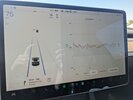OK, I've pondered thus some more, and yes, my previous explanation was wrong. I'm sorry about that. I love physics and cannot believe I made that error.

Wind force increases with speed squared. This makes intuitive sense. As speed doubles, you are hitting each air molecule twice as hard and you are hitting twice as many per unit of time.
With the wind force growing as a square with speed, the power needed to overcome this force is cubed. This is also intuitive. If you double the speed you are pushing against four times the force at twice the rate, so you need 8x the power.
So why does the measured data show the energy consumes per mile going up nearly linearly with speed at highway speeds?
Wind resistance isn't as dominant at highway speeds as I would have thought. From
https://www.tesla.com/sites/default/files/blog_attachments/the-slipperiest-car-on-the-road.pdf, a 2012 Model S at 70 MPH needs only 14 HP to overcome the air resistance at 70 MPH and 42 HP at 100 MPH. This follows the speed cubed (100/70)^3*14=41 as expected.
At 70 MPH, the MS consumes roughly 300 Wh/mi of energy. This means it is using ~300 Wh/mi * 70 mi / hr = 21000 watts to drive. I don't know the efficiency of the drive system, but let's suppose it's 90%. The HP used to move the car at 70 MPH = 21000 watts / (746 watts/HP) * 90% = 25 HP. The air resistance took 14 HP, so the rest (mostly rolling resistance) takes 11 HP.
Now you go 80 MPH, and the expected energy needed will be ~80/70*300= 342 Wh/mi. This equates to 342*80=27360 watts --> 33 HP. The power to overcome the air resistance = (80/70)^3*14=21, so the rest of the system takes 33-21=12 HP. The rolling resistance remains about constant, and the power needed to overcome it scales linearly with speed (80/70*11=12.6).
Bottom line:
1. Air resistance grows with speed^2.
2. Power needed to overcome this grows with speed^3.
3. At highway speeds (50-80), the needed power grows roughly with speed^2, so the consumption grows roughly linearly with speed. This is because the cubed term is only part of the equation.
Naturally, the system is much more complex, but this captures some of the key factors.



